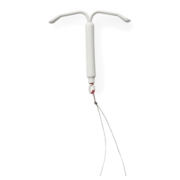Hello, Skyla! Getting to know the newest IUD
A new IUD option hits the U.S. market—and it’s (officially) for ladies without kids.

Update: Skyla is no longer the new kid on the block. Two more hormonal IUDs, LILETTA and Kyleena, are now available as well. Let’s hear it for choices!
Birth control has many wonderful qualities—but being one-size-fits-all isn’t one of them. So when a new birth control option becomes available—especially one that’s long-acting and super-effective—well, let’s just say it’s kind of a big deal.
So…what’s the new option?
This new option is an IUD called Skyla. Like the other IUDs on the U.S. market, Mirena and Paragard, Skyla sits inside the uterus and is more than 99% effective at preventing pregnancy. It’s made by the same company that makes the Mirena IUD—and it works pretty much the same way, by releasing a low dose of levonorgestrel, a hormone that thickens cervical mucus and blocks sperm.
How does Skyla compare to Mirena and Paragard?
Skyla, Mirena, and Paragard have some important things in common. All three of these IUDs are t-shaped devices that sit in your uterus and prevent more than 99 out of 100 pregnancies in a year—which means they’re among the most effective birth control methods in the world. All three IUDs can be removed at any time with a quick trip to a health care provider—and once they’re out, you should be able to get pregnant right away.
There are some differences too. Skyla is kind of like a little sister for Mirena. It’s slightly smaller, slightly lower-dose, and the tube used to place it in the uterus is slightly narrower.
What about benefits—and side effects?
Since Skyla works in a similar way to big sis’ Mirena, the benefits and side effects are pretty similar—but there are a few differences worth noting.
- Decreased cramps. Skyla works the same way Mirena does to decrease period cramps and pain for most women.
- Good thing, smaller package. Skyla’s slightly smaller frame and narrower placement tube are intended to make it more comfortable to insert and use compared to other IUDs, especially for young women and women who haven’t had a child. (Still, no one’s claiming IUD placement is a walk in the park.)
- Hassle-free, but for less time. Unlike other hormonal methods, IUDs don’t require regular trips to the clinic or pharmacy. All IUDs are convenient like that, but Skyla’s good for a maximum of 3 years—instead of Mirena’s 5 years or Paragard’s 12 years.
- Lighter periods. Both Skyla and Mirena cause changes in bleeding patterns: more spotting at first, and then lighter and shorter periods after the first six months.
- Aunt Flo still visits. For most women using Skyla, their period won’t stop altogether. Only one in 17 Skyla users stop having a period after a year, and about one in eight have no period if they use it for longer. Compare that to Mirena: about one in five Mirena users stop having a period after a year, and one in three if they use it for longer.
Who’s Skyla good for?
While we, along with some very important people in the medical community, have been saying for what feels like ages that all IUDs are safe for almost all women, rumors persist that they’re only for women who’ve already had kids. Hopefully Skyla, which has been tested and marketed specifically for women who haven’t had kids yet, will put those rumors to rest.
There are many reasons why these rumors persist, but perhaps the most obvious one is that Bayer only recommends the Mirena for use by women who have already had a child. Modern IUDs are safely used by millions of women who haven’t had a child—so why do the ads say Mirena shouldn’t be used by these women? The answer lies with the law and the U.S. Food and Drug Administration (FDA). The FDA approved Mirena based on studies that included only women who had a child, so Bayer is prohibited by law from talking about any other kinds of women in their advertising—it’s considered an “off-label” use.
Skyla, on the other hand, was tested and FDA-approved for women who have no children, so the company will be able to advertise directly to those women. A physician who studied Skyla, Dr. Anita Nelson, notes that there was no difference in the effectiveness of Skyla for women with versus without children. “Skyla may be used by women whether or not they have had a child, which should alert more clinicians that nulliparous women are still good candidates for IUDs. I also like having a shorter acting IUD to diversify the market and give women more choices.”
When and where can I get Skyla?
Skyla is on the market and you should be able to get it from a health care provider near you. It’s still relatively new, so it may take some time for health care providers to get comfortable prescribing and inserting it and for insurance providers to include it in their coverage.
How much does Skyla cost?
If you have health insurance, Skyla, like other prescription birth control methods, should be covered without additional out-of-pocket costs. For folks without insurance or with coverage that’s exempt from the new health care rules, we’ve heard Skyla can cost between$650 - $780. If you don’t have insurance and don’t think you can afford the up-front costs of an IUD, don’t give up without investigating your options. You may be able to get payment assistance or even get birth control free of charge through local health programs. And keep in mind that once the IUD is inserted, it lasts for up to three years, so even at full-price it’s a great value.
How do you feel about this article?

Heat up your weekends with our best sex tips and so much more.
